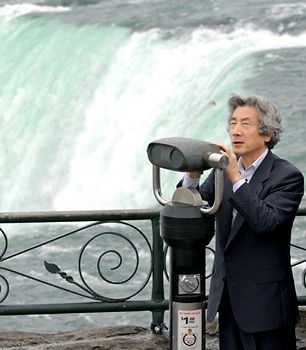I would like to present translations of two different articles on the use of whale meet in school lunches in Japan with little additional comment. These articles are actually half a year old, but they appeared on the exact same day, which makes the contrast all the more striking. My personal take on this issue is contained in this post and comments on Adam’s recent post. Now to me, one of these sounds like a real news article and one sound like propagandistic fluff, but you be the judge. As an aside, if you are looking for some English language material in support of Japanese whaling activities, there’s an entire blog of it here.
Whale meat is super delicious
Students at the No.5 Kouyou Elementary school have “nostalgic school lunch”
 For the school lunch week from the 23rd to the 27th a menu item from the mid 1950s to mid 1960s named as “nostalgic school lunch” re-appeared for several days running at an elementary school of Mukou City, Kyoto prefecture. On the 27th whale meat with sweat and sour sauce made an appearance, and this rare menu was sampled with pleasure by the children.
For the school lunch week from the 23rd to the 27th a menu item from the mid 1950s to mid 1960s named as “nostalgic school lunch” re-appeared for several days running at an elementary school of Mukou City, Kyoto prefecture. On the 27th whale meat with sweat and sour sauce made an appearance, and this rare menu was sampled with pleasure by the children.
The plan was to deepen the students understanding of the history and significance of school lunches. Nutritionists created the dished by consulting menus from 1957-1968 that had been preserved by Kouyou Elementary. Boiled cabbage, mixed pork and beans-even these basic foods were provided.
On this day, the menu at No.5 Kouyou Elementary had four dishes: whale with sweat and sour sauce, sesame marinated vegetables, white rice and miso soup. The whale, which these days rarely appears in school lunches, was mink whale caught for study. The whale meat was cut into cubes, deep fried with wheat flour, and slathered with sweet and sour sauce. Although it was the first time the children had eaten whale, they were delighted saying “it’s super delicious!” They never stopped asking for second helpings.
At the same school there is also a display in the hall way outside the computer lab to introduce the children to the history of school lunches, starting in 1949, and telling them about the changed in menu and preparation methods.
A week of school lunches
Whale meet appears on menu at elementary schools in this prefecture, etc.
January 27, 2006
 The pan-Japan school lunch week began on the 24th, and on the 25th Tatsuta-fry made with whale meat appeared on the menu at Tanabe City’s Uwaakitsu Elementary School (Haraakira Komatsu, principal). In the prefecture a total of 174 Elementary, Junior High and other schools served school lunches using whale meat throughout the week.
The pan-Japan school lunch week began on the 24th, and on the 25th Tatsuta-fry made with whale meat appeared on the menu at Tanabe City’s Uwaakitsu Elementary School (Haraakira Komatsu, principal). In the prefecture a total of 174 Elementary, Junior High and other schools served school lunches using whale meat throughout the week.
Throughout the week a variety of functions were carried out to increase the awareness of children and students, teachers, guardians and area residents towards school lunches. In this prefecture they promoted this by making school lunches using various traditional and locally grown ingredients.
This is the second time that whale meat has appeared in Uwaakitsu Elementary school, the first having been March of last year. On this day the “taste of Wakayama Prefecture” menu also included the other dishes of vegetable and plum rice, boiled egg and kouya style frozen tofu, and ponkan oranges grown locally in Uwaakitsu.
In their own classrooms, the children tasted the dish which they hadn’t had in a long time. Wakana Sugi, a second year girl said of the whale meat, “I guess it’s kind of tough.”
Whale meat has largely disappeared from school lunches since commercial whaling temporarily ceased in 1982. The prefectural school lunch association called on the city, town and village education association to use whale meat to try and move along the children’s education of Wakayama food culture, and it began to appear in school lunches in January of last year.
There are also plans in Tokyo, Osaka, Kyoto and Nara prefectures to use whale meat in school lunches throughout this month.
The Ministry of Education, in commemoration of the first test school lunches in Chiba, Tokyo and Kanagawa Prefectures starting on December 24 1946, every year designates a “school lunch week” starting on January 24th, but not conflicting with winter vacation.

